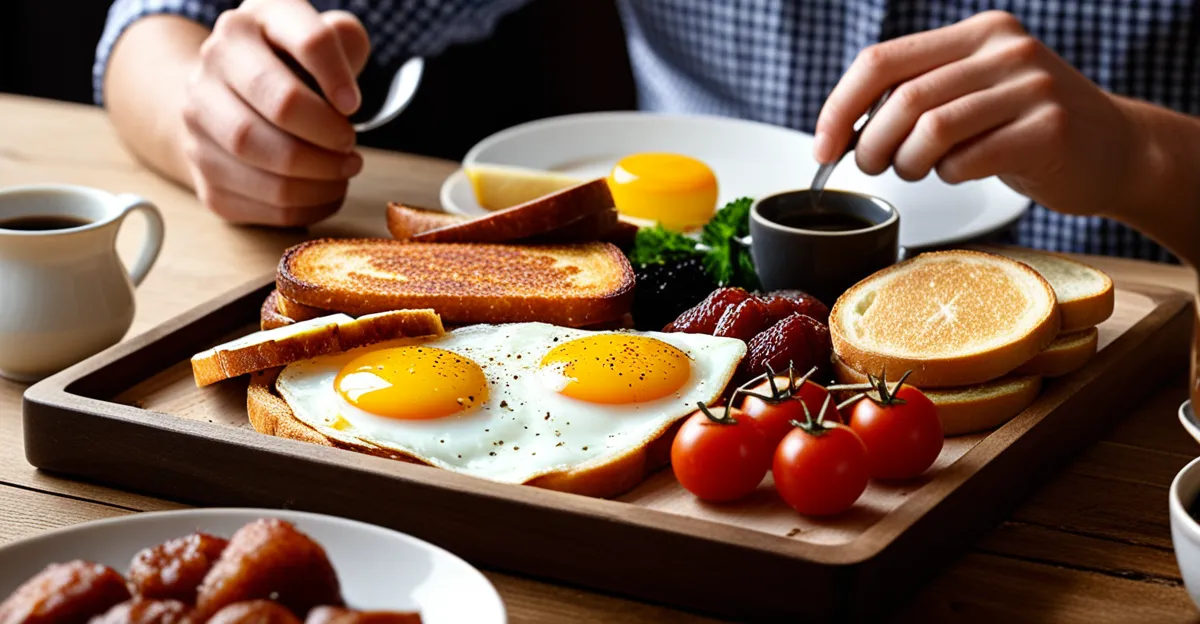Essential Ingredients for a Traditional English Breakfast
A traditional English breakfast relies on several key ingredients that form its hearty and satisfying character. At the heart of this breakfast are classic proteins: quality bacon, sausages, and eggs. Opting for thick-cut back bacon or streaky bacon enhances the meaty flavor and texture. Sausages should be fresh and well-seasoned, ideally from local butchers for authentic taste. When selecting eggs, freshness is paramount as they can be fried, scrambled, or poached depending on your preference.
Beyond proteins, important English breakfast ingredients include baked beans, grilled or fried tomatoes, and sautéed mushrooms. Baked beans add a sweet, tangy contrast, while tomatoes bring a juicy freshness to the dish. Mushrooms, when cooked correctly, provide an earthy depth that balances the richness of meats. Black pudding is also considered a traditional component, lending a distinct, savory flavor; quality black pudding is firm and well-spiced.
Also to discover : What are the best techniques for cooking a savory beef Wellington?
Bread is essential for the full experience. Choose proper breakfast staples such as thick-cut white or wholemeal bread for toasting. Some prefer buttered fried bread for added richness, although this is a matter of personal taste. These ingredients combine to create a balanced and authentic plate, showcasing why the traditional English breakfast remains celebrated for its variety and robustness.
Optimal Cooking Techniques for Each Component
Cooking a traditional English breakfast to perfection requires mastering specific English breakfast cooking methods for each ingredient. Choosing between frying and grilling is fundamental. Grilling bacon and sausages allows excess fat to drain, resulting in a leaner texture with crisp edges. Frying, however, imparts a rich, caramelized flavor, especially when frying back bacon or streaky bacon in moderate heat to avoid burning.
Have you seen this : How Can Traditional British Recipes Be Modernized?
Egg preparation is a key focus within breakfast preparation tips. For a classic fry-up, eggs should be cooked in butter to a softly set consistency with runny yolks for maximum taste. Scrambled eggs demand gentle, continuous stirring over low heat to achieve a creamy texture without dryness. Poached eggs require simmering water with a splash of vinegar to help whites coagulate quickly, producing a tender, silky finish.
When it comes to vegetables and beans, correct cooking enhances their natural flavors. Baked beans should be gently heated on low to avoid splitting the sauce, preserving sweetness and thickness. Tomatoes benefit from grilling or pan-frying cut-side down over moderate heat until caramelized, intensifying their juicy freshness. Mushrooms are best sautéed with butter and a pinch of salt, releasing their earthy aroma without becoming soggy.
Mastering these fry-up techniques ensures balance between texture and flavor, respecting the traditional character of each breakfast staple. Attention to detail elevates the overall dish, making every bite satisfying and authentic.
Order of Preparation
Timing is crucial in executing a traditional English breakfast flawlessly. Understanding the English breakfast order ensures each element reaches the plate hot and at its best texture. Since proteins like bacon and sausages take longer to cook than eggs or vegetables, they should be started first. Grilling or frying sausages and bacon typically needs 10–15 minutes, depending on thickness and heat level.
Once meats are underway, prepping mushrooms and tomatoes follows. Because mushrooms sauté quickly and tomatoes benefit from moderate heat caramelization, beginning these after the meats allows staggered cooking without overcrowding pans. Baked beans require a gentle warm-up on low heat, often done toward the end of meat preparation since they only need reheating rather than cooking.
Eggs, being the most delicate, are best cooked last. This avoids overcooking while other ingredients finish and plate. For fried or scrambled eggs, precise heat control and timing (usually 2-4 minutes) are essential to achieve the desired consistency. Poached eggs demand close attention to timing—typically 3 minutes per egg in simmering water—to ensure tender whites and runny yolks.
To keep components warm without compromising texture, use low oven heat or warm plates. This strategy preserves crispiness in bacon and sausages while preventing eggs from drying out. Efficient multitasking—such as preparing bread to toast while monitoring eggs—and organizing cooking stations streamlines the process. This coordinated approach is key to mastering the English breakfast order and delivering a hot, balanced plate every time.
Enhancing Flavor and Authenticity
Explore how to bring out the best taste and true character in your traditional English breakfast.
Creating a truly authentic traditional English breakfast hinges on subtle yet impactful choices that elevate flavor without overshadowing the core ingredients. A key English breakfast flavor tip is to integrate fresh herbs like thyme or parsley during cooking—these add a fresh, aromatic layer that complements both meats and vegetables. For instance, a sprig of thyme sautéed with mushrooms intensifies earthiness, while chopped parsley sprinkled over eggs brightens richness.
Seasoning must be purposeful. Simply using freshly cracked black pepper and a pinch of sea salt on eggs and tomatoes enhances natural flavors. Avoid overpowering spices; the hallmark of a traditional English breakfast is balance, letting the primary ingredients sing. Light seasoning of sausages and black pudding before cooking brings mild warmth and preserves their distinctive taste.
Selecting traditional sauces and condiments is vital for authenticity. Classic English mustard or brown sauce provides tang and heat, pairing perfectly with sausages and bacon without masking them. HP Sauce remains a beloved choice, prized for its sweet, smoky notes. A side of malt vinegar can enliven fried bread or mushrooms, imparting a subtle acidic contrast.
Regional touches add another layer of genuineness. In northern England, serving with oatcakes or adding pease pudding brings local heritage to the table. Scottish variations might include tattie scones, while in the Midlands, a dab of black treacle deepens sweetness. These nuances preserve the authenticity of the breakfast while offering delightful diversity.
By focusing on thoughtful seasoning, fresh herbs, and traditional accompaniments, your English breakfast gains depth, warmth, and a distinctive character that respects its roots and enhances every bite.
Serving and Presentation Tips
Discover how to present and serve your traditional English breakfast with style and authenticity.
Serving an authentic traditional English breakfast requires attention to both appearance and practical details. Proper breakfast presentation enhances the meal’s appeal and honors the dish’s rich heritage. Start by arranging components thoughtfully on the plate, allowing each item to stand out without overcrowding. Placing sausages and bacon side by side, eggs centrally, and vegetables like tomatoes and mushrooms neatly contained prevents mingling of flavors and keeps textures distinct.
Serving English breakfast often involves toasted bread or fried bread as a base or side. Toast should be golden and crisp, ideally prepared just before plating to preserve crunch. Managing condiments is equally important; small ramekins or separate plates for brown sauce, mustard, and ketchup keep the table tidy and allow customization without overpowering the core flavors.
The choice of dishware influences traditions too. Classic white plates highlight the food’s vibrant colors, while a warm plate helps maintain temperature. Garnish with a sprinkle of fresh parsley or a light dusting of black pepper on eggs for added visual appeal and subtle flavor enhancement.
Ultimately, successful breakfast presentation means balancing function and authenticity. The goal is a visually inviting plate that showcases traditional English breakfast ingredients beautifully, inviting diners to enjoy a hearty, well-composed meal that respects time-honored style.











